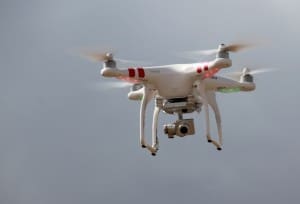 Animal activists using aerial drones to spy on farms is a new reality for Australian agriculture, and particularly for Australia’s feedlot sector.
Animal activists using aerial drones to spy on farms is a new reality for Australian agriculture, and particularly for Australia’s feedlot sector.
But does the industry simply have to accept flying intrusions over its land, or does it have grounds to push back?
Brisbane-based agribusiness lawyer and social media ‘agvocate’ Trent Thorne, from McCullough Robertson, tackled this question at the BeefEx conference at the Gold Coast on Thursday.
His findings contrast with media comments made by Mark Pearson of Animal Liberation NSW last year, where the animal rights activist stridently claimed the group is legally entitled to spy on agricultural operations from above.
“Our legal advice is that if you’re no nearer than 10 metres above the ground, and you’re not filming in anyone’s houses, you can go ahead,” Mr Pearson said, as reported by media articles last year.
However Mr Thorne said the law was not as clear cut as Mr Pearson suggested, pointing out that existing laws against trespass, nuisance and breach of privacy, and proposed laws recommended by the Australian Law Reform Commission, could offer agricultural operations some protecting from aerial spying .
Trespass
Mr Thorne said intrusions into airspace may amount to trespass under current law if the intrusion is at a height that interferes with the ‘ordinary use and enjoyment’ of the occupier.
It could be readily argued that most drones fly at heights which would affect the use and enjoyment of the relevant property.
However a scarcity of case authority exists to deal with these types of intrusion.
Nuisance
The argument that drones cause a nuisance may offer more fertile ground on which to base a proceeding under current law, Mr Thorne said.
Drones not only presented clear physical dangers – for example a young man in the US was decapitated by his model helicopter last year – but also the capacity to unsettle cattle in yards.
“If the cattle spook, which is a distinct possibility, there is the perverse chance that they could be injured by the animal rights groups that are allegedly there to look out for their welfare,” Mr Thorne said.
In considering whether there has been a nuisance, a court will look at whether there has been substantial and unreasonable interference with the owner’s use and enjoyment of the land.
However Mr Thorne added that making out a viable cause of action in nuisance was not a simple proposition, and the potential damages that may be payable to the plaintiff if the proceeding is successful may be minimal.
Do privacy laws offer protection?
On the question of privacy, Mr Thorne said many would be surprised to learn that the Commonwealth Privacy Act as it presently stands does not readily protect private citizens.
The legislation is essentially designed with data protection as its core driving principle, and does not provide overarching privacy protection for the individual.
In past decisions of relevance, the High Court has ruled that when operations are required to be licensed by a public authority, which is the case in the feedlot industry, information about the nature of those operations is not confidential.
With respect to the issue of illegally obtained footage, the High Court has also ruled that the mere fact that footage was obtained improperly did not subsequently taint its use and publication for every other person into whose hands the film may fall.
ALRC recommendations
Invasions of privacy have become the focus of significant attention with the Australian Law Reform Commission recently handing down its report on ‘Serious invasions of privacy in the digital era’.
The ALRC has recommended a new statutory cause of action for serious invasion of privacy.
There are five elements, and each of them must be satisfied for the plaintiff to have a cause of action:
(a) the invasion of privacy must occur by:
(i) intrusion into the plaintiff’s seclusion or private affairs (including by unlawful surveillance) i.e. watching, listening or recording someone’s private activities or affairs; or
(ii) misuse or disclosure of private information about the plaintiff;
(b) the invasion of privacy must be either intentional or reckless;
(c) a person in the position of the plaintiff would have had a reasonable expectation of privacy in all of the circumstances;
(d) the court must consider that the invasion of privacy was ‘serious’, in all the circumstances, having regard to, among other things, whether the invasion was likely to be highly offensive, distressing or harmful to a person of ordinary sensibilities in the position of the plaintiff.
The court must be satisfied that the plaintiff’s interest in privacy outweighs the defendant’s interest in freedom of expression and any broader public interest in the defendant’s conduct.
Critically, and maybe of most importance, it is recommended that the new tort should only be actionable by natural persons.
(Mr Thorne said the ALRC had erred in his opinion by not proposing to extend the tort of serious invasion of privacy to protect the privacy of a corporation. There were innumerable examples of family run farms held in corporate trust structures or alternative operating entities, but still individuals who should not have to be subjected to unnecessary and intrusive invasion into their private business operations.)
In determining whether a person would have had a reasonable expectation of privacy in all of the circumstances, the ALRC is also proposed that a court may consider, among other things:
(a) the nature of the private information, including whether it relates to intimate or family matters, health or medical matters, or financial matters;
(b) the means used to obtain the private information or to intrude upon seclusion, including the use of any device or technology;
(c) the place where the intrusion occurred;
(d) the purpose of the misuse, disclosure or intrusion;
(e) whether and to what extent the private information was already in the public domain;
(f) whether the plaintiff consented to the conduct of the defendant; and
(g) the extent to which the plaintiff had manifested a desire not to have his or her privacy invaded.
At present in Australia there are less than 100 licensed civilian drone operators registered with CASA.
Recreational operators do not need a license, which essentially means that the drone must go no higher than 122 metres, can only be operated in daylight, must always be in line of sight of the operator and cannot be operated within 5.5km of an airport.
A House of Representatives Standing Committee recently recommended that the Australian Government consider introducing legislation by July 2015 to provide protection against privacy-invasive technologies (including remotely piloted aircraft), with particular emphasis on protecting against intrusions on a person’s seclusion or private affairs.
WA Senator Chris Back has also proposed a Private Senator’s Bill to deal with the recent increase in farm raids and trespassing by animal rights activists. Senator Back (and other members of parliament) has been especially critical of the regular delays by animal rights activists of handing footage of alleged cruelty to relevant prosecutorial authorities.
There are two main aspects to the draft Bill, namely:
(a) any party with images or recordings of suspected animal cruelty are required to submit formal reports to relevant authorities within 24 hours and/or provide the relevant images within 48 hours to enable these authorities to quickly prevent alleged further acts of cruelty; and
(b) the imposition of stricter penalties for people who trespass, vandalise or threaten the operation of lawful animal enterprises.
Think local
Mr Thorne believes that working with their local Government could be an effective strategy for feedlots concerned about protecting their right to privacy.
Unlicensed drone operators need to be conscious of the fact that they are subject to local council by-laws. For example, there is a reasonable expectation that major gathering areas for people, e.g. football stadiums, beaches, music festivals etc, may be subject to a prohibition of operation (without appropriate authorisation) due to the increased risk of injury.
“I would submit that this should be a legitimate avenue of enquiry for all feedlot operators given the importance of your respective operations to your local economies.
“If you can sound out local councillors in relation to their attitudes, this might be the simplest and cheapest solution to overcoming the problem created by the animal activists.
“If a by-law was enacted, a feedlot operator would then only be required to post a sign on the boundary that drones are prohibited without the express written authority of the property owner.”
‘You can only imagine the indignation from these groups if such an intrusion was foisted upon them’
Mr Thorne said a line had to be drawn when it came to groups that aimed to deliberately paint livestock production in a poor light through selective editing and sensationalised reporting to urban consumers who were becoming increasingly further removed from how their food ends up in the supermarket and on their plates.
“You can only imagine the howls of indignation that would emanate from these groups about the breaches of their civil liberties if such an intrusion was foisted upon them.
“This is clearly an area that is ripe for exploitation by these groups and as an industry, we should not allow it to become the norm that when you head out to work of a morning, you can expect a drone to be hovering above your yards.
“The law needs to catch up with the reality of this situation and the rights of law abiding producers need to be protected and should not be eroded by people who have no idea what they’re talking about and who have no skin in the game.”

